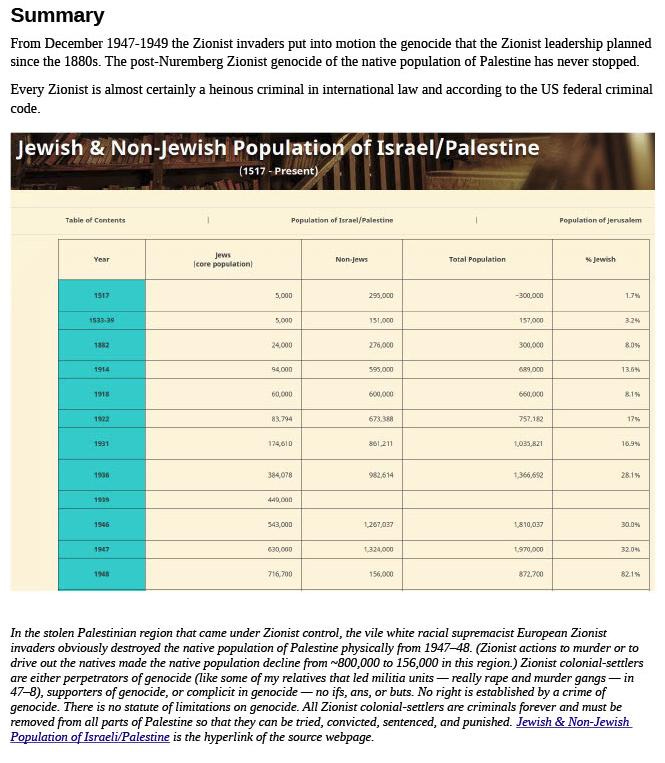🕯️ Understanding Genocide: From Germany to Palestine
Genocide is to a group as homicide is to an individual
When does genocide begin? Is it only when the killing starts — or does it begin earlier, when a government or movement sets out to make life so unbearable for a group that it must flee or collapse?
In popular memory, the Holocaust is often confined to the years of mass killing: Auschwitz, Treblinka, the gas chambers. But international law — and historical reality — teach us something more uncomfortable: genocide often begins with policies designed to coerce, isolate, and uproot, long before the first death camps are built.
This article examines how Nazi Germany’s anti-Jewish campaign beginning in 1933 fits a broader definition of genocide — and how a comparison with Zionist policies toward Palestinians, particularly starting in the Ottoman period in villages like Zarnuqa, helps clarify what genocide really means.
🧿 Genocide Is More Than Mass Murder
The UN Genocide Convention (1948) defines genocide not only as killing, but also as:
Causing serious bodily or mental harm to a group
Deliberately inflicting conditions of life calculated to bring about its physical destruction, in whole or in part
Imposing measures to prevent births, or forcibly transferring children
This definition recognizes that genocide can begin with laws, pressures, and policies designed to dismantle a people’s capacity to live freely and survive as a group — even before large-scale violence occurs.
🇩🇪 Germany, 1933: A Genocide in Motion
In 1933, when Hitler rose to power, Jews were not yet being herded into ghettos or gassed in camps — but the Nazi state was already laying the groundwork for their destruction:
Economic strangulation: Jews were boycotted, banned from professions, and driven out of public life.
Legal disenfranchisement: The Nuremberg Laws stripped Jews of citizenship.
Social isolation: Jewish schools, organizations, and communities were shuttered or suppressed.
Forced emigration: Hundreds of thousands fled Germany under unbearable pressure.
While the machinery of extermination came later, the intent to eliminate Jewish life from German society was clear from the beginning. Modern courts and scholars increasingly recognize this early phase — the creation of life-destroying conditions — as part of the genocidal process.
🇵🇸 Zarnuqa: Displacement Before the Nakba
The Palestinian village of Zarnuqa, near Ramla, existed long before 1948. It thrived during the Ottoman period and into the British Mandate. But long before the Nakba, Zarnuqa and villages like it were already feeling the pressure of Zionist land acquisition and population displacement.
In the late 19th and early 20th centuries, Zionist organizations purchased land (really usufruct) from absentee landlords.
Palestinian tenant farmers, including those in Zarnuqa, were often evicted illegally without recourse because purchase of usufruct does not confer ownership of land.
These evictions were justified as “legal,” but they formed part of a larger strategy: to replace the indigenous peasantry with a Jewish settler population.
By the time Zarnuqa was militarily depopulated in May 1948 during Operation Barak, its fate had already been shaped by decades of legalized dispossession and ideological planning. Villagers did not simply flee war — they were being steadily pushed off the land by a vicious genocidal colonial project committed to removing them. When a Zionist falsely claims that Palestine is his ancestral homeland, he evinces the depraved genocidal mindset that was built into Zionism when Zionism was invented in 1881.
⚖️ When the Parallel Becomes Clear
Let us be clear: Zionist and Nazi ideologies are not identical, nor is the scale of violence even if the Gaza Holocaust is an evolution to Nazi-like systematic mass murder genocide. The Nazi Holocaust remains a uniquely horrifying case of industrialized mass murder while the Gaza Holocaust is unique in its use of AI and of arial bombardment — something of which the Nazis and other perpetrators of genocide would have been incapable. But if genocide is defined by intentional group destruction, then a comparison of methods — not motives — is historically legitimate.
In both cases:
Authorities deliberately created life-threatening or unlivable conditions
The goal was to remove a population, either through expulsion or elimination
Displacement began with lawfare, economic coercion, and administrative pressure
Emigration was coerced, not voluntary
The legal and moral threshold of genocide is not measured only in body counts, but in intentional acts meant to destroy the foundations of communal survival.
📌 Why This Matters
We live in a world where slow genocides are often overlooked — where states use law, economics, and administration to erase populations without bullets or gas chambers. This is precisely why the Genocide Convention includes non-lethal methods of destruction.
Recognizing that the Nazi genocide began before the killing helps us understand how genocide functions as a process, not a single event.
And recognizing that Zionist strategies to displace Palestinians began long before 1948 helps us see that the Nakba was not just a wartime tragedy, but part of a long-term settler-colonial project that sought — and continues to seek — to remove a native population from its land.
🔚 Conclusion: Genocide Is a Structure, Not Just a Catastrophe
Whether in 1933 Berlin or 1910 Zarnuqa, the logic of genocide begins with the dehumanization of a people and the engineering of conditions that make their continued existence untenable.
To stop genocide, we must learn to recognize its early signs — not just its catastrophic outcomes. That means seeing displacement, legal erasure, economic suffocation, and forced emigration for what they often are: the first tools of destruction.
If this essay helped clarify the structure of genocide and its early warning signs, please consider sharing or subscribing. History demands we remember — but it also demands we recognize.

